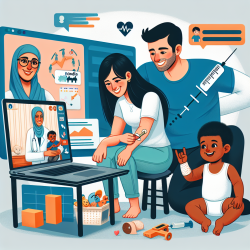Introduction
In the realm of pediatric care, managing needle pain effectively remains a critical challenge. Despite the availability of evidence-based strategies, these are often underutilized, leaving children to endure unnecessary discomfort. The study titled "Implementation Effectiveness of a Parent-Directed YouTube Video ('It Doesn’t Have To Hurt') on Evidence-Based Strategies to Manage Needle Pain: Descriptive Survey Study" sheds light on an innovative approach to disseminate this crucial information to parents, thereby empowering them to play an active role in their child's healthcare.
Study Overview
The research aimed to evaluate the effectiveness of a YouTube video designed to educate parents on managing needle pain using evidence-based strategies. The video, featuring a young child, emphasizes distraction, deep breathing, and topical anesthetic creams as key techniques. Over five years, the video garnered over 237,000 views from 182 countries, indicating significant reach and acceptance among parents and healthcare professionals (HCPs).
Key Findings
- High Acceptance: Both parents and HCPs reported a strong acceptance of the video, finding it helpful and confidence-boosting in managing needle pain.
- Behavioral Intent: There was a notable increase in the intention to use the suggested pain management strategies, particularly deep breathing and topical anesthetic creams.
- Global Reach: The video achieved significant penetration, reaching a wide international audience, and was viewed primarily by women aged 25-44.
Implications for Practitioners
For practitioners in the field of speech-language pathology and pediatric care, the study underscores the importance of utilizing digital platforms to disseminate evidence-based information. Here are some actionable insights:
- Leverage Social Media: Use platforms like YouTube to reach parents with engaging, evidence-based content that can empower them to manage their child's pain effectively.
- Encourage Parental Involvement: Advocate for parents to be active participants in their child's healthcare by providing them with accessible resources and strategies.
- Collaborate with Experts: Partner with communication specialists to create high-quality, engaging content that can effectively convey complex information to a lay audience.
Conclusion
The study highlights the potential of parent-directed educational videos in transforming pediatric pain management practices. By embracing digital media, practitioners can bridge the gap between research and practice, ensuring that evidence-based strategies are not only known but also implemented by parents and caregivers.
To read the original research paper, please follow this link: Implementation Effectiveness of a Parent-Directed YouTube Video (“It Doesn’t Have To Hurt”) on Evidence-Based Strategies to Manage Needle Pain: Descriptive Survey Study.










